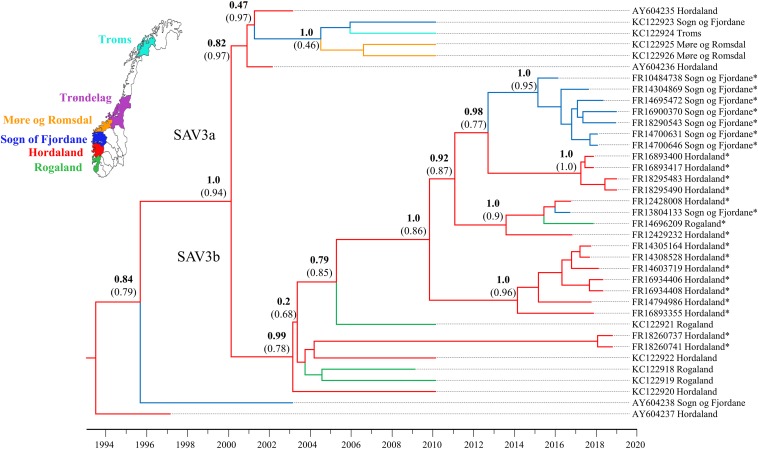Understanding the dynamics of pathogen transfer in aquaculture systems is essential to manage and mitigate disease outbreaks.
The goal of this study was to understand recent transmission dynamics of salmonid alphavirus (SAV) in Norway. SAV causes significant economic impacts on farmed salmonids in European aquaculture. SAV is classified into six subtypes, with Norway having ongoing epidemics of SAV subtypes 2 and 3.
These two viral subtypes are present in largely distinct geographic regions of Norway, with SAV2 present in Trondelag, SAV3 in Rogaland, Sogn og Fjordane, and Hordaland, and Møre og Romsdal having outbreaks of both subtypes.
To determine likely transmission routes of Norwegian SAV an established Nanopore amplicon sequencing approach was used in the current study.
After confirming the accuracy of this approach for distinguishing subtype level co-infections of SAV2 and SAV3, a hypothetical possibility in regions of neighboring epidemics, twenty-four SAV3 genomes were sequenced to characterize the current genetic diversity of SAV3 in Norwegian aquaculture.
Sequencing was performed on naturally infected heart tissues originating from a range of geographic locations sampled between 2016 and 2019. Phylogenetic analyses revealed that the currently active SAV3 strains sampled comprise several distinct lineages sharing an ancestor that existed ∼15 years ago (95% HPD, 12.51-17.7 years) and likely in Hordaland.
At least five of these lineages have not shared a common ancestor for 7.85 years (95% HPD, 5.39-10.96 years) or more.

Furthermore, the ancestor of the strains that were sampled outside of Hordaland (Sogn of Fjordane and Rogaland) existed less than 8 years ago, indicating a lack of long-term viral reservoirs in these counties. This evident lack of geographically distinct subclades is compatible with a source-sink transmission dynamic explaining the long-term movements of SAV around Norway. Such anthropogenic transport of the virus indicates that at least for sink counties, biosecurity strategies might be effective in mitigating the ongoing SAV epidemic.
Finally, genomic analyses of SAV sequences were performed, offering novel insights into the prevalence of SAV genomes containing defective deletions.
Overall, this study improves our understanding of the recent transmission dynamics and biology of the SAV epidemic affecting Norwegian aquaculture.
